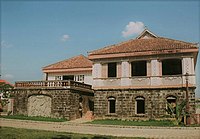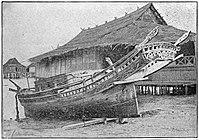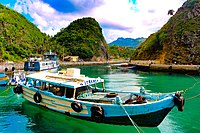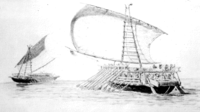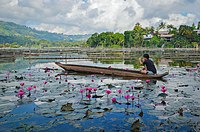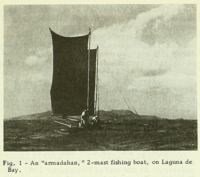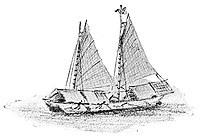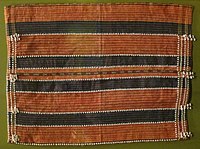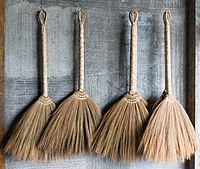
A | B | C | D | E | F | G | H | CH | I | J | K | L | M | N | O | P | Q | R | S | T | U | V | W | X | Y | Z | 0 | 1 | 2 | 3 | 4 | 5 | 6 | 7 | 8 | 9
This article contains too many pictures for its overall length. (January 2022) |
| Part of a series on the |
| Culture of the Philippines |
|---|
 |
| Society |
| Arts and literature |
| Other |
| Symbols |
|
Philippines portal |
The arts in the Philippines reflect a range of artistic influences on the country's culture, including indigenous art. Philippine art consists of two branches: traditional[1] and non-traditional art.[2] Each branch is divided into categories and subcategories.
Overview
The National Commission for Culture and the Arts, the cultural agency of the Philippine government, has categorized Filipino arts as traditional and non-traditional. Each category has sub-categories.
- Traditional arts:[1]
- Ethnomedicine – including the arts of hilot and the arts of the albularyo and babaylans[3]
- Folk architecture – including stilt, land, and aerial houses.
- Maritime transport – boat houses, boat-making, and maritime traditions.
- Weaving – including back-strap loom weaving and other, related forms of weaving.
- Carving – including woodcarving and folk non-clay sculpture.
- Folk performing arts – including dances, plays, and dramas.
- Folk (oral) literature – including epics, songs, and myths.
- Folk graphic and plastic arts – including calligraphy, tattooing, writing, drawing, and painting
- Ornaments – including mask-making, accessory-making, ornamental metal crafts
- Textile (fiber) art – including headgear weaving, basketry, and fishing gear
- Pottery – including ceramics, clay pots and sculpture
- Other artistic expressions of traditional culture – including non-ornamental metal crafts, martial arts, supernatural healing arts, medicinal arts, and constellation traditions
- Non-traditional arts:[2]
- Dance – including choreography, direction, and performance
- Music – including composition, direction, and performance
- Theater – including direction, performance, production design, lighting and sound design, and playwriting
- Visual arts – including painting, non-folk sculpture, printmaking, photography, installation art, mixed-media works, illustration, graphic arts, performance art, and imaging
- Literature – including poetry, fiction, essays, and literary or art criticism
- Film and broadcast arts – including direction, writing, production design, cinematography, editing, animation, performance, and new media
- Architecture and allied arts – including non-folk architecture, interior design, landscape architecture, and urban design
- Design – including industrial and fashion design
-
Madonna with Child, ivory statue with silver; unknown 17th-century artist
-
Singkil, a dance based on the Darangen (an Intangible Cultural Heritage and a National Cultural Treasure)
Traditional arts
Traditional arts in the Philippines include folk architecture, maritime transport, weaving, carving, folk performing arts, folk (oral) literature, folk graphic and plastic arts, ornaments, textile or fiber art, pottery, and other artistic expressions of traditional culture.[1] Traditional artists or groups of artists receive the National Living Treasures Award (Gawad Manlilikha ng Bayan Award (GAMABA)) for their contributions to the country's intangible cultural heritage.
Ethnomedicine

Ethnomedicine is one of the oldest traditional arts in the Philippines. Traditions (and objects associated with them) are performed by medical artisans and shamans. Practices, grounded on the physical elements, are an ancient science and art. Herbal remedies, complementing mental, emotional, and spiritual techniques, are also part of many traditions as well. The category was added to the GAMABA in 2020.[3]
Folk architecture
Folk architecture in the Philippines varies by ethnic group, and structures are made of bamboo, wood, rock, coral, rattan, grass, and other materials. They include the hut-style bahay kubo, highland houses (known as bale) with four to eight sides, the coral houses of Batanes which protect from the area's harsh, sandy winds, the royal torogan (engraved with an intricate okir motif) and palaces such as the Darul Jambangan (Palace of Flowers), the residence of the sultan of Sulu before colonization. Folk architecture also includes religious buildings, generally called spirit houses, which are shrines to protective spirits or gods.[4][5][6] Most are open-air, house-like buildings made of native materials.[7][4] Some were originally pagoda-like (a style continued by natives who converted to Islam), and are now rare.[8] Other buildings have indigenous and Hispanic motifs (bahay na bato architecture and its prototypes). Many bahay na bato buildings are in Vigan, a World Heritage Site.[9] Folk structures range from simple, sacred stick stands to indigenous castles or fortresses (such as Batanes' ijangs and geological alterations such as the Rice Terraces of the Philippine Cordilleras (another World Heritage Site).[10][11][12][13]
-
Painting of shamanhood and ethnomedicine, including rituals
-
Some bahay na bato houses
-
Dakay house, the oldest surviving coral houses in the Batanes still used today (c. 1887)
-
Rice Terraces of the Philippine Cordilleras, World Heritage Site and a National Cultural Treasure
-
Batad Rice Terraces
Maritime transport
Maritime transport includes boat houses, boat-making, and maritime traditions. These structures, traditionally made of wood chosen by elders and crafters, connected the islands. Although boats are believed to have been used in the archipelago for thousands of years, the earliest evidence of boat-making has been carbon-dated to 689 AD: the Butuan boats identified as large balangays.[14][15][16] In addition to the balangay, indigenous boats include the two-masted double-outrigger fishing armadahan,[17][18] the avang trading ship,[19] the awang dugout canoes,[20] the balación sailing outrigger boat,[21] the bangka,[22] the bangka anak-anak canoe,[23] the salambáw-lifting basnigan,[24] the bigiw double-outrigger sailboat,[25] the birau dugout canoe,[23] the buggoh dugout canoe,[23] the casco barge,[26] the single mast and pointed chinarem,[19] the rough-sea open-deck chinedkeran,[19] the djenging double-outrigger plank boat,[23] the garay pirate ship,[27] the guilalo sailing outrigger ship,[28] the falua open-deck boat,[19] the junkun canoe,[23] the motorized junkung,[29] the outrigger karakoa and lanong warships,[30][31] the lepa houseboat,[32] the ontang raft,[23] the owong lake canoe,[33] the open-deck fishing boat panineman,[19] the double-outrigger paraw sailboat,[34] the salisipan war canoe,[35] the tataya fishing boat,[19] the motorized tempel, the dinghy tiririt,[36] and the outrigger vinta.[37] From 1565 to 1815, Manila galleons were built by Filipino artisans.[38]
-
A large karakoa outrigger warship, 1711
-
A balangay reconstruction
-
The Sama-Bajau's lepa house-boat with elaborate carvings
-
A large lanong outrigger warship, 1890
-
Filipino boat-builders in a Cavite shipyard (1899)
-
Garay warships of the Banguingui
-
An armadahan at Laguna de Bay (1968)
-
War canoe salisipan, 1890
-
Painting of a balación, 1847
-
Some of the remains of the Butuan Balangay (689-988 AD), a National Cultural Treasure
-
A Manila galleon visiting Micronesia, c. 1590s
-
A casco, 1906
Weaving
Weaving is an ancient art form, and each ethnic group has a distinct weaving technique.[39] The weaving arts include basket weaving, back-strap loom weaving, headgear weaving, and fishnet weaving.
Cloth and mat weaving

Valuable textiles are made with a back strap loom.[40] Fibers such as cotton, abaca, banana fiber, grass, and palm are used in Filipino weaving.[41] There are a number of types of woven cloth. Pinilian is an Ilocano cotton cloth woven with a pangablan, using binakul, binetwagan, or tinumballitan styles. Bontoc weave emphasizes the concept of centeredness, key to the culture of the Bontoc people. The weave begins with the sides (langkit), followed by the pa-ikid (side panels), fatawil (warp bands), and shukyong (arrows). The sinamaki weaving then begins, incorporating a tinagtakho (human figure), minatmata (diamond), and tinitiko (zigzag). The last is the center (pa-khawa), with the kan-ay (supplementary weft). Kalinga textiles contain geometric designs; one motif is a lozenge pattern known as inata-ata. Piña is considered the finest indigenous Filipino textile. Aklanon textiles are used in national costumes. Hablon is the textile of the Karay-a and Hiligaynon peoples. Tapestry woven by the Yakan people uses the bunga-sama supplementary weft weave, the siniluan warp-floating pattern, the inalaman supplementary-weft technique, and the pinantupan weft-band pattern. Blaan weaving depicts crocodiles and curls. The Mandaya use a mud-dye technique. Meranaw textiles are used for the malong and other Maranao clothing. T'nalak is a Tboli textile.[42] The oldest known ikat textile in Southeast Asia is the Banton cloth, dating to the 13th to 14th centuries.[43]
Unlike cloth weaving with a loom, mats are woven by hand. They are woven in cool shade, and are kept cool to preserve their integrity. An example is the banig of Basey, where its weavers usually work in a cave. Fibers include banana, grass, and palm.[44]
-
Panel made of silk, piña, and metallic threads (1800s)
-
Northern Luzon textile used in skirt
Basketry
Baskets have intricate designs, styles and forms for specific purposes, such as harvesting, rice storage, traveling, and sword storage. Basket weaving is believed to have arrived with north-to-south human migration. Some of the finest baskets made are from Palawan, in the southwest. Materials vary by ethnic group, and include bamboo, rattan, pandan, cotton tassels, beeswax, abacá, bark, and dyes. Basketry patterns include closed crossed-over underweave, closed bamboo double-twill weave, and a spaced rattan pentagon pattern. Products include the tupil (lunch box), bukug (basket), kabil (carrying basket), uppig (lunch basket), tagga-i (rice basket), bay'ung (basket pouch), lig-o (winnowing tray), and binga (bag).[45][46] Weaving traditions have been influenced by modern demands.[47]
Woven headpieces are common, and cultures use a variety of fibers to create headgear such as the Ivatan vakul and the snake headpiece of the Bontoc.[48] Woven fish traps are a specialty of the Ilocano people.[49] Broom weaving is another tradition, exemplified by the Kalinga people.[50]
-
Various rice baskets
-
Filipino tobacco basket
-
Pasiking or basket bags
-
Ivatan woman wearing a vakul
-
T'boli women utilizing the s'laong kinibang in dance
-
Weaved hornbill headgear of the Ilongot
-
Gaddang people's weaved headgear
-
Filipino weaved hats
-
Ilocano merchants wearing the headgear kattukong and raincoat annangá
-
Ifugao brooms
-
Zdroj:https://en.wikipedia.org?pojem=Philippine_Art
Text je dostupný za podmienok Creative Commons Attribution/Share-Alike License 3.0 Unported; prípadne za ďalších podmienok. Podrobnejšie informácie nájdete na stránke Podmienky použitia.
Antropológia
Aplikované vedy
Bibliometria
Dejiny vedy
Encyklopédie
Filozofia vedy
Forenzné vedy
Humanitné vedy
Knižničná veda
Kryogenika
Kryptológia
Kulturológia
Literárna veda
Medzidisciplinárne oblasti
Metódy kvantitatívnej analýzy
Metavedy
Metodika
Text je dostupný za podmienok Creative
Commons Attribution/Share-Alike License 3.0 Unported; prípadne za ďalších
podmienok.
Podrobnejšie informácie nájdete na stránke Podmienky
použitia.
www.astronomia.sk | www.biologia.sk | www.botanika.sk | www.dejiny.sk | www.economy.sk | www.elektrotechnika.sk | www.estetika.sk | www.farmakologia.sk | www.filozofia.sk | Fyzika | www.futurologia.sk | www.genetika.sk | www.chemia.sk | www.lingvistika.sk | www.politologia.sk | www.psychologia.sk | www.sexuologia.sk | www.sociologia.sk | www.veda.sk I www.zoologia.sk





